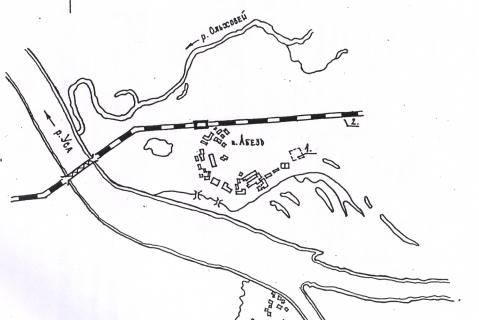The Memorial cemetery is located on the outskirts of Abez. The first burials date back to 1947-1948. Most burials were made in 1949-1957 when prisoners from Minlag camp outpost No 1 (the Abez camp for Minlag disabled) were interred here. At first they were buried in trenches; after 1952 in individual graves. Posts bearing a number or letter on a plaque were erected on the graves. In total, about 2,000 people were buried here.
The names of over 1,000 Minlag prisoners buried in this cemetery have been restored from the archives. Creating memorials and tidying the cemetery began in 1989 when a bell was erected there and a memorial plaque with the words, “Thousands lie here”. The first memorial was a pyramid of sheet metal with a wreath of barbed wire and a wooden plaque: “To the innocent victims of repression, 1930s-1950s. May they never be forgotten. Peace eternal.”
In 1990, through the efforts of the Vilnius Society of Political Exiles, a memorial Flaming Cross was erected 200 metres from the cemetery. It was designed by Lithuanian sculptor Jonas Judisus, son of General Judisus who died in a Soviet labour camp. In July 1996, the Poshuk Society from Lviv put up a metal cross with an inscription in Ukrainian: “May we never forget the political prisoners of Intalag, who died in Abez in 1946-1954”. In 1999, two commemorative crosses were erected in memory of Poles and Belorussians who died in captivity. In 2003, the Inta museum of history and local studies reconstructed in metal about 500 of the surviving wooden number plates; this work continued in 2009-2012. Since 1990, moreover, several dozen individual memorials have been created within the cemetery, to the philosopher Lev Karsavin (1888-1952), the historian Nikolai Punin (1888-1953), General Jonas Judisus (1892-1950) and many others.
(The 1999 map shows the location of Abez and [1] the memorial cemetery in relation to the Usa river and its tributary, the Olkhovsky river. On the west bank of the Usa river is Old Abez [11-191] and across the bridge, but not indicated here, is the Usa rail station [11-37].)// Compare 11-90 map.
Information about some deceased Gulag inmates can be found in Memorial’s Victims of Political Terror database with its 3 million entries, or in the Open List database (“Victims of Political Repression in the USSR, 1917-1991”).
Because of frequent transfers of prisoners between camps it is usually very difficult to locate the final resting place of any Gulag inmate.
| Date | Nature of ceremonies | Organiser or responsible person | Participants | Frequency |
|---|---|---|---|---|
|
1 November
|
Solemn events marking Remembrance Day for the Victims of Political Repression
|
Inta town administration, Inta Museum
|
Inta town officials, Inta Museum staff, Ukrainian and Lithuanian societies in Inta, descendants of the victims, Inta town inhabitants
|
Annual event
|
|
nk
|
Commemorative masses
|
nk
|
nk
|
From time to time
|
| State of burials | Area | Boundaries |
|---|---|---|
|
The numbered stakes on the prisoners' graves have survived in some cases
|
3.75 hectares
|
partially delineated
|
[ original texts and hyperlinks ]
Archive of the Inta museum of history and local studies
Reply No 06-17-1230 (dated 30 April 2014) from the Komi Republic Ministry of Culture to a formal enquiry by RIC Memorial (St Petersburg)

